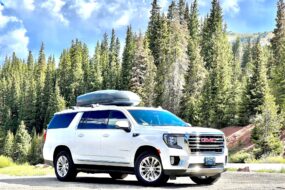Automated vehicle barrier (AVB) is a kind of safety device that stops a car from driving in the wrong direction. These are commonly installed at public places such as train stations, airports, sports stadiums and more to prevent accidents. AVBs work by sending an electromagnetic pulse into the air around the road. If any vehicles move towards it, the signal will be blocked. The vehicle will not be able to pass through and thus, avoid the accident.
In addition, AVBs also come in a variety of shapes, sizes, designs and colors. They can range from simple metal plates to complex multi-layered systems with sensors that detect speed, acceleration and distance traveled by the cars.
How Does It Work?
An example of how an AVB works is shown here. When you activate this, you would notice a green light on top of the barrier. As soon as you approach it, you will see the flashing red light and hear a loud noise. This means the system has detected your car approaching the wall.
Automated Vehicle Barrier – History
The automated vehicle barriers were first introduced in the early 2000s. Since that time, many companies have been working on developing them. However, no one has yet created a fully functional version of the system.
However, these systems could be used to protect against crime. The idea behind the concept was to create an electronic fence that would prevent cars from entering certain areas.
This technology is also being considered by the government as part of their plans to reduce traffic congestion in major cities around the world.
In fact, the United States Department of Transportation is planning to spend $1 billion on the project.
They hope to use the technology to make roads safer and more efficient.
It is hoped that this will help to cut down on accidents and increase safety for drivers.
So how does it work? Well, each lane has sensors that are connected to a central computer. This means that the computers can tell when a car enters or leaves the area.
When this happens, the system alerts the driver so that they know there is someone else in the road ahead.
The driver is then given the option of changing lanes or continuing straight. If they choose to change lanes, then the vehicle barrier will open up in front of them.
Automated Vehicle Barrier – Types
When you’re driving down the road, you need to be aware of any potential dangers that may appear on your side of the road. You should also keep an eye out for pedestrians who might wander into traffic without looking first. Unfortunately, there are times when drivers don’t notice a pedestrian until it is too late.
In order to help prevent these accidents from happening, many states have installed automated vehicle barriers at certain locations along the roads. These barriers are designed to automatically detect vehicles traveling in either direction, and then alert the driver by using lights or sounds.
There are two different types of automated vehicle barriers:
1. The “Do Not Enter” type is used to stop cars that are approaching a construction zone or other area where it’s dangerous for people to walk around. This barrier will sound its horn or flash warning lights whenever a car comes within a few feet.
2. The “Stop” type is used to slow down the speed of a specific car. If you use this device, the barrier will activate when an approaching vehicle gets close enough to cause a collision. It will then slowly move forward in front of that vehicle, causing the driver to slam on their brakes.
Advantages of Automated Vehicle Barrier
When you’re driving on the road today, there’s no doubt that you have to be aware of other vehicles around you. This means that you need to watch out for cars coming towards you from behind, as well as keep your eyes open so that you don’t end up hitting someone else.
But this isn’t always possible. You might be stuck in traffic, and it’s hard to focus on the road when you’re trying to figure out how to get through the congestion.
However, a new type of technology is being developed by the government. It allows you to drive safely while you’re waiting for a gap in the traffic.
The system uses sensors that detect the speed of the car in front of you. If there’s enough space between the two vehicles, then the driver can use the brake pedal. But if the distance is too small, the brakes won’t work. Instead, the system will automatically apply the accelerator, allowing the driver to pass.
This makes driving much safer, because you’ll never have to worry about crashing into another vehicle.
So what are some of the advantages of this kind of technology?
It saves time. When you’re in a jam on the highway, then having to wait for a break in the traffic could take hours or even days.
Disadvantages of Automated Vehicle Barrier
When you have an accident, you need to be able to get yourself away from the scene quickly. This means that you should use your car to help you move. If you don’t want to leave anything behind, then you can always buy an automatic vehicle barrier. Here are some advantages of using one of these barriers.
You will no longer have to worry about getting stuck in traffic. You won’t have any problems moving around, because the barrier is designed to make sure that you can easily drive through it.
If you’re having a problem with someone else driving erratically, then you shouldn’t hesitate to call the police. The barrier will automatically alert them to your situation and they’ll come and rescue you.
In addition to this, you’ll also save money. When you’re buying an automated vehicle barrier, you’re not paying for the installation. It’s already built into the price of the product.
As well as this, you’ll reduce the risk of injury. By purchasing a barrier, you’ll avoid being trapped in your own car.
How Does an Automatic Boom Barrier Work?
When you want to keep your kids safe while driving, you should invest in an automated vehicle barrier. This type of device is designed to prevent vehicles from entering a restricted area. There are many different models available on the market today.
One such model is the automatic boom barrier. As the name suggests, this product automatically extends its arm when it senses that someone might be trying to enter the protected zone. The boom itself can reach up to 10 meters. That means it can easily block off an entire road or driveway.
In addition, these barriers can also sense moving objects. If they detect a car approaching, they will extend their arms and stop the vehicle in time.
This type of safety system is very easy to install. All you have to do is connect the base unit to a power source. Then, you just need to plug the extension cable into any outlet. Finally, you’ll need to attach the boom to the wall.
You’re now ready to use the boom. When you’re done, simply remove the extension cable.

What Is the Future of the Automated Vehicle Barrier?
In the near future, the number of accidents caused by human error will decrease dramatically. The reason why is that driverless vehicles can make sure that everyone gets home safely. However, there are still many questions surrounding these new technologies. For example, how long will it take for them to become a part of everyday life? Will the technology be affordable enough for all drivers? And, most importantly, will people want to use the systems?
One thing that we do know for certain is that automated vehicle barriers are already being used around the world. In fact, they have been in place for years. But what happens when they disappear? If you’re wondering what the future of the automated vehicle barrier looks like, then you might find the information below useful.
First off, it’s important to note that the current generation of autonomous cars are not self-driving. Instead, they rely on sensors and cameras that allow them to detect obstacles in their path. Once a car detects an obstacle, the system will automatically apply brakes or reverse direction.
It’s also worth noting that the first fully automatic vehicles were actually designed back in the 1940s. Since then, there have been many improvements made to the technology. Nowadays, the majority of automated vehicle barriers are able to handle any type of road condition.









